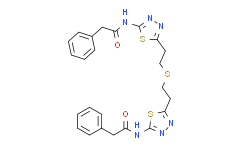| Cas No.: | 314045-39-1 |
| Chemical Name: | N,N'-[Sulfanediylbis(Ethane-2,1-Diyl-1,3,4-Thiadiazole-5,2-Diyl)]bis(2-Phenylacetamide) |
| Synonyms: | 2-phenyl-N-[5-[2-[2-[5-[(2-phenylacetyl)amino]-1,3,4-thiadiazol-2-yl]ethylsulfanyl]ethyl]-1,3,4-thiadiazol-2-yl]acetamide;Bis-2-(5-phenylacetamido-1,3,4-thiadiazol-2-yl)ethyl sulfide;BPTES;N,N'-[sulfanediylbis(Ethane-2,1-Diyl-1,3,4-Thiadiazole-5,2-Diyl)]bis(2-Phenylacetamide);2,2'-(5,5'-(2,2'-thiobis(ethane-2,1-diyl))bis(1,3,4-thiadiazole-5,2-diyl))bis(azanediyl)bis(1-phenylethanone);N,N'-((thiobis(ethane-2,1-diyl))bis(1,3,4-thiadiazole-5,2-diyl))bis(2-phenylacetamide) |
| SMILES: | S(C([H])([H])C([H])([H])C1=NN=C(N([H])C(C([H])([H])C2C([H])=C([H])C([H])=C([H])C=2[H])=O)S1)C([H])([H])C([H])([H])C1=NN=C(N([H])C(C([H])([H])C2C([H])=C([H])C([H])=C([H])C=2[H])=O)S1 |
| Formula: | C24H24N6O2S3 |
| M.Wt: | 524.6814 |
| Sotrage: | 2 years -20°C Powder, 2 weeks 4°C in DMSO, 6 months -80°C in DMSO |
| Description: | BPTES is an allosteric and selective glutaminase inhibitor with an IC50 of 0.16 μM. |
| In Vivo: | BPTES-NPs (BPTES nanoparticles, 1.2 mg BPTES in 100 µL nanoparticles, i.v.) significantly attenuates tumor growth in the patient-derived pancreatic orthotopic tumor model[1]. |
| In Vitro: | BPTES (10 µM) exhibits inhibition of PDAC cell proliferation[1]. BPTES preferentially slows growth of mutant IDH1 cells without inducing apoptosis. BPTES (10 µM) reduces glutaminase activity in both WT and mutant IDH1 expressing cells, diminishes glutamate and α-KG levels, and increases glycolytic intermediates while leaving total 2-HG levels unaffected[2]. BPTES (10 µM) shows a clear synergistic anti-cancer effect with 10 μM of 5-FU in A549 and EKVX cell lines, and results in a growth reduction response not only in EKVX and A549 but also in most of the NSCLC cell lines[3]. BPTES (10 µM) effectively reduces the levels of the metabolites of the TCA cycle, with no changes in the levels of metabolites in glycolysis and the pentose phosphate pathway. BPTES treatment reduces about 30% ATP production under normoxia, and an additional 10% reduction of ATP production is observed under hypoxia in EKVX[4]. |






















